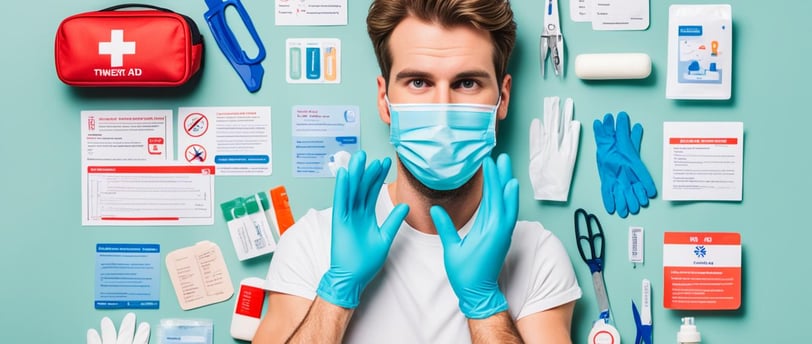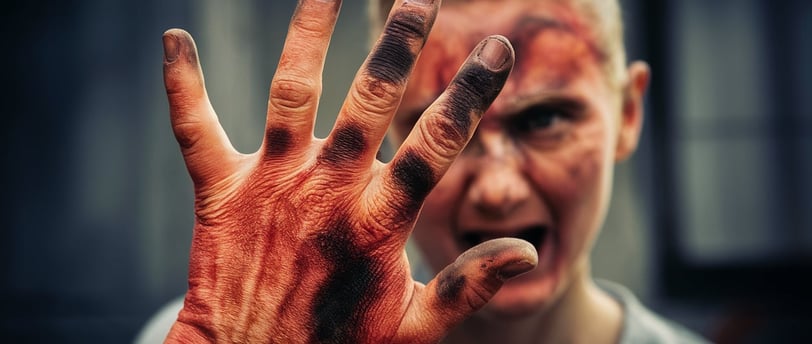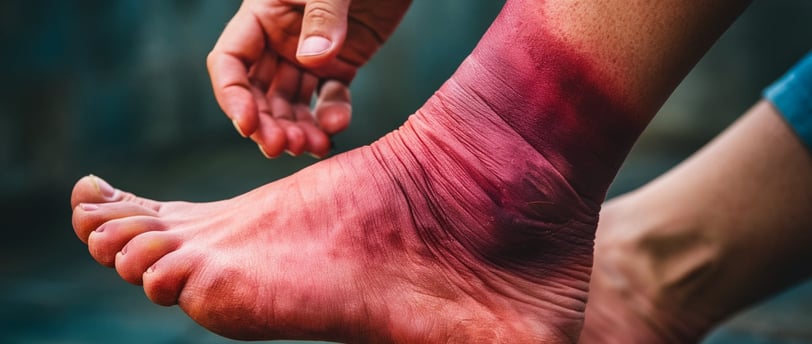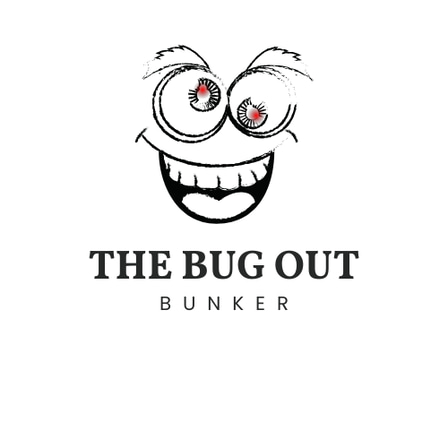Essential First Aid Basics for Emergencies
Learn the essential first aid basics you need to handle emergencies with confidence. This post covers critical skills like CPR, wound care, and dealing with common injuries, ensuring you're prepared to act swiftly and effectively in any crisis. Equip yourself with the knowledge that could save a life.
The Bug Out Bunker
8/16/20249 min read


Ever wondered how to stay calm and take action when an emergency strikes?
Knowing these first aid basics could make all the difference when every second counts.
First aid is the immediate care a sick or injured person gets.
It may be the only care a person needs. Or, it helps prevent a condition from getting worse until help arrives.
The best way to prepare for these events is to get official first-aid training.
This article will cover the first aid steps for different situations.
It will also explain when you should look for more advanced medical care.
Key Takeaways
Knowing first aid can help you stay calm and take effective action during emergencies.
First aid can be the only care needed or a way to prevent a person's condition from worsening until professional help arrives.
Receiving official first-aid training is the best way to prepare for medical emergencies.
This article covers the essential first aid steps to follow in different situations.
Recognizing when more advanced medical care is needed is crucial.
Understanding the ABCs of First Aid
In emergency situations, knowing first aid basics can save lives. The key is the ABCs: Airway, Breathing, and Circulation. Let's look at each part and see how they help in emergencies.
Airway: Clearing the Airway
If someone is not awake or responding, start by making sure their airway is open. Do this by tilting their head back and lifting their chin. If they're choking, you might need to use the Heimlich maneuver to clear the blockage.
Breathing: Rescue Breathing Techniques
After clearing the airway, check if the person is breathing. If not, you must give rescue breathing. Pinch their nose, seal your mouth over theirs, and breathe into their mouth. Watch for their chest to rise. Keep doing this until they start breathing again or help comes.
Circulation: Chest Compressions and CPR
If there's no pulse, start chest compressions right away. Put one hand in the center of their chest and the other on top. Compress at 100-120 beats per minute, letting the chest fully spring back. If you know CPR techniques, give rescue breaths between compressions.
The first aid basics, like airway management, rescue breathing, and CPR techniques, are key in emergencies. Getting first aid training prepares you to act quickly and with confidence in a crisis.
"Knowing and practicing the ABCs of first aid can empower anyone to save a life in an emergency."
Responding to Cardiac Emergencies
In a medical emergency, knowing how to spot cardiac arrest signs is key. Learning CPR and how to use an AED can save lives. These skills are vital for anyone wanting to help in cardiac emergencies.
Recognizing Cardiac Arrest Signs
Spotting cardiac arrest signs quickly is crucial. Look for:
Sudden loss of consciousness
No pulse or irregular breathing
Chest pain or discomfort
Shortness of breath
If you see these cardiac arrest signs, act fast. Start emergency procedures right away.
Performing CPR and Using AEDs
After spotting cardiac arrest, start CPR techniques. This means doing chest compressions and giving rescue breaths. It helps keep blood and oxygen flowing until help arrives. Many places have AEDs for giving shocks to restart the heart.
"Immediate CPR and AED use can double or triple a person's chance of survival from cardiac arrest."
Getting first aid training is the best way to learn CPR techniques and AED use. These skills could save a life in an emergency.

Controlling Severe Bleeding
When someone gets hurt and bleeds, knowing about blood is key. The color and flow of blood tell us how bad the injury is. Luckily, almost all bleeding can be stopped with the right first aid.
Assessing Bleeding Types and Severity
The bleeding type shows how serious the injury is. Arterial bleeding means bright red blood that spurts with the heartbeat, showing a serious wound. Venous bleeding is darker red and steady, while capillary bleeding is just oozing.
Applying Pressure and Bandages
Put on disposable gloves to protect yourself.
Rinse the wound with clean water to remove debris.
Cover the wound with a clean gauze pad or cloth.
Apply firm, direct pressure to the wound to stop the bleeding and encourage clotting.
Do not remove the cloth if it becomes soaked; instead, add more layers as needed.
"Proper wound care and bleeding control are essential first aid techniques that can mean the difference between life and death in an emergency situation."
By knowing the signs of different bleeding types and using the right first aid techniques, you can control severe bleeding. This could save a life.
Handling Choking Incidents
Choking can be scary, but knowing how to act fast can save lives. Spotting the signs and doing the Heimlich maneuver are key skills. They can be lifesavers.
Recognizing Choking Signs
First, you need to know the signs of choking. A choking person can't speak, cough, or breathe well. They might grab their throat, turn blue, or look really scared. If you see these signs, act quickly.
Performing the Heimlich Maneuver
The Heimlich maneuver uses stomach thrusts to clear a blockage. Stand behind the person and put one hand on their belly just above the belly button. Use your other hand to make a fist and push in and up. Keep doing this until the blockage is gone.
If the person loses consciousness, call for help right away. Put them on their back, tilt their head back, and do five chest compressions. Then, give two rescue breaths. Keep doing this until help comes or they start breathing again.
"Choking incidents can happen to anyone, at any time. Being prepared with the right first aid techniques can mean the difference between life and death."
Knowing the choking signs and the Heimlich maneuver helps you act fast in emergencies. Remember, every second counts. Stay calm and act quickly.
First aid basics for emergencies
Being ready with first aid skills can change everything in a crisis. It's crucial for medical emergencies, natural disasters, or accidents. Giving immediate care before help arrives can save lives. But, it's hard to remember the right steps in a stressful moment.
We've made a simple guide to help you act right when it matters. You can print it, keep it in your car, or in your bag. This way, you'll be ready to handle first aid basics, emergency preparedness, medical emergencies, and first responder training situations fast and well.
Check the scene for safety and call 911 (USA) 000 (Australia) if needed.
See if the person is breathing and give rescue breaths if not.
Stop severe bleeding by applying pressure.
Do CPR if the person isn't awake and not breathing.
Keep the person warm and raise their legs to treat shock.
Watch the person's health until help arrives.
"Knowing first aid can mean the difference between life and death in an emergency situation. Being prepared with the right knowledge and skills can empower you to act quickly and confidently to help others."
The main aim of first aid is to give quick, temporary care until experts get there. By learning these key first aid basics, you'll be more ready for emergency preparedness, medical emergencies, and first responder training situations. This will give you confidence to help others.
Treating Burns Effectively
Burn injuries are serious and need quick action. Knowing how to treat them is key. The first step in burn treatment is to stop the burning. Remove the heat source and cool the area.
Identifying Burn Degrees
Burn severity depends on how deep the injury is. There are three main burn degrees to know:
First-degree burns only touch the outer skin layer, causing redness and swelling.
Second-degree burns hit two skin layers, leading to blisters, redness, and swelling.
Third-degree burns go deeper, affecting many layers, and skin may look white or black and feel numb.
Major burns that cover a lot of skin or go deep need quick medical help.
Cooling and Bandaging Burns
For minor burn first aid, follow these steps:
Flush the burn with cool water for a few minutes.
Put a light, sterile gauze bandage on the area.
Don't break any blisters that form.
Get medical help if the burn is severe or big.
Good burn care helps prevent more damage and aids healing. Always be cautious with burn treatment.
"The best way to treat a burn is to prevent it from happening in the first place."


Head and Neck Injury Management
When emergencies happen, it's key to handle head and neck injuries right. These injuries, like concussions or spinal cord damage, need quick action to stop more harm. Knowing the right steps can really help protect the injured person.
If someone might have a head injury or neck injury, the first step is to keep their head and neck still. Don't move them unless you need to keep their airway open or stop bleeding. If they're not waking up, having trouble breathing, or bleeding a lot, call 911 right away.
Gently hold the head in a neutral position, supporting it from both sides to prevent any movement.
Avoid twisting, bending, or turning the head and neck, as this can potentially exacerbate the injury.
If the person is conscious, advise them to remain still and avoid moving their head or neck.
Monitor the person's breathing and circulation, and be prepared to administer first aid techniques if needed.
"Proper injury management is crucial in the initial response to head and neck trauma, as it can mean the difference between a favorable outcome and a life-altering complication."
By sticking to these steps and staying calm, you can help prevent more head and neck injuries. This can also help the injured person recover better. Always put the injured person's safety first.
Responding to Fractures and Sprains
Handling first aid emergencies for fractures and sprains is key. Fractures, or broken bones, need quick action to stop more damage and help healing. Sprains, which stretch or tear ligaments, also require fast care to ease pain and aid recovery.
Immobilizing Fractures
If you think someone has a fracture, the first thing to do is immobilize the area. Use a splint or sling to keep the limb or joint still. Don't try to fix the broken bone yourself, as it could make things worse. Just support the area gently and use ice to lessen swelling and pain.
Treating Sprains with RICE
For sprains, the RICE method is a good first step. RICE means:
Rest the injured area to prevent further damage.
Ice the affected area to reduce swelling and pain.
Compress the injury with a bandage to provide support.
Elevate the injured limb above the level of the heart to help reduce swelling.
If the pain and swelling don't get better in a few days, or if the injury looks bad, get medical help. Quick and proper first aid can greatly help in healing fractures and sprains.
"Immobilizing fractures and applying the RICE method for sprains can significantly improve the outcome and prevent further injury."


Poisoning and Overdose Response
Emergencies like poisoning and overdose are very serious and need quick action. As a first aid responder, knowing how to spot the signs and help until help comes is key.
If someone might have been poisoned or overdosed, the first thing to do is call 911 right away. Don't make them vomit unless a poison control center or a doctor tells you to. Vomiting can sometimes make things worse and cause more problems.
If the person is not awake, not responding, or having trouble breathing, start rescue breathing and CPR if needed. Keeping their airway open and giving rescue breaths is very important. Stay with the person until help gets there and give any info you have about the poison or overdose.
"Act quickly, but don't take unnecessary risks. Your safety and the safety of the victim are the top priorities in a poisoning or overdose emergency."
Knowing the signs of poisoning or overdose and acting fast can really help save a life. By staying calm, calling for help, and giving basic first aid, you can help increase the chances of a good outcome in these stressful situations.
Remember, in cases of poisoning and overdose, time is very important. Being ready and knowing the right first aid steps can be the key to a good outcome instead of a bad one.
Conclusion
Learning first aid is key to saving lives in emergencies. You can learn skills like CPR, stopping bleeding, and helping with choking or poisoning. This makes you ready to help until help arrives.
First aid training is a big help in emergencies. It's useful for anyone, from parents to first responders. It teaches you how to act fast and save lives. By learning first aid, you can help your community stay safe.
First aid skills are important for everyone. They help you be ready for emergencies. By learning these skills, you can be a big help in a crisis. Start your first aid training today and become a first responder.
FAQ
What is the basic principle of first aid for an unconscious or unresponsive person?
First aid for an unresponsive person is all about ABC: airway, breathing, and circulation. You must open their airway, check if they breathe, and keep their blood flowing with chest compressions.
Why is cardiopulmonary resuscitation (CPR) an important emergency medical procedure?
CPR is key because it can restart a stopped heart and keep blood flowing. This helps until a defibrillator can restart the heart naturally. It's a lifesaver.
How can you control bleeding from an injury?
To stop bleeding, wear disposable gloves, clean the wound, and cover it with gauze or cloth. Apply pressure to help clotting. If the cloth gets soaked, add more layers instead of removing it.
Source Links
https://www.verywellhealth.com/basic-first-aid-procedures-1298578 - Basic First Aid You Should Know
https://www.betterhealth.vic.gov.au/health/conditionsandtreatments/first-aid-basics-and-drsabcd - First aid basics and DRSABCD
https://www.redcross.org/take-a-class/first-aid/performing-first-aid/first-aid-steps - First Aid Steps | Perform First Aid | Red Cross
Thanks and best regards
The Bug Out Bunker
Visit the link below and discover The US Army’s Forgotten Food Miracle
And 126 Superfoods That You Can Store Without Refrigeration for Years
This post may contain affiliate links. If you make a purchase through one of these links, we may earn a small commission at no additional cost to you. We only recommend products and services that we have personally used and believe will add value to our readers. Your support helps us continue to provide valuable content. Thank you for your support!
Survival
Stay prepared for any scenario with our expert insights.
© 2024. All rights reserved.
